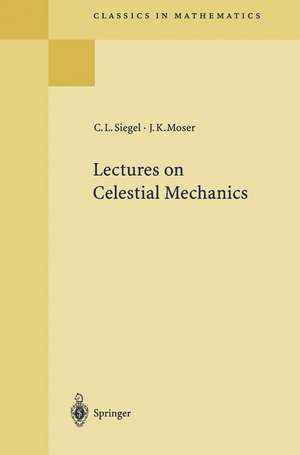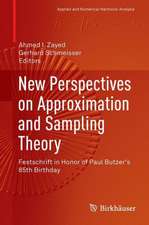Lectures on Celestial Mechanics: Classics in Mathematics
Autor Carl L. Siegel Traducere de C.I. Kalme Autor Jürgen K. Moseren Limba Engleză Paperback – 15 feb 1995
Din seria Classics in Mathematics
-
 Preț: 404.20 lei
Preț: 404.20 lei -
 Preț: 428.09 lei
Preț: 428.09 lei -
 Preț: 400.48 lei
Preț: 400.48 lei -
 Preț: 404.37 lei
Preț: 404.37 lei -
 Preț: 402.28 lei
Preț: 402.28 lei -
 Preț: 422.11 lei
Preț: 422.11 lei -
 Preț: 438.87 lei
Preț: 438.87 lei -
 Preț: 431.56 lei
Preț: 431.56 lei -
 Preț: 425.80 lei
Preț: 425.80 lei -
 Preț: 429.61 lei
Preț: 429.61 lei -
 Preț: 421.72 lei
Preț: 421.72 lei -
 Preț: 425.80 lei
Preț: 425.80 lei -
 Preț: 422.90 lei
Preț: 422.90 lei -
 Preț: 427.49 lei
Preț: 427.49 lei -
 Preț: 421.17 lei
Preț: 421.17 lei -
 Preț: 415.39 lei
Preț: 415.39 lei -
 Preț: 485.07 lei
Preț: 485.07 lei -
 Preț: 437.72 lei
Preț: 437.72 lei -
 Preț: 444.47 lei
Preț: 444.47 lei -
 Preț: 440.39 lei
Preț: 440.39 lei -
 Preț: 447.73 lei
Preț: 447.73 lei -
 Preț: 438.10 lei
Preț: 438.10 lei -
 Preț: 509.50 lei
Preț: 509.50 lei -
 Preț: 418.83 lei
Preț: 418.83 lei -
 Preț: 436.74 lei
Preț: 436.74 lei -
 Preț: 446.37 lei
Preț: 446.37 lei -
 Preț: 430.59 lei
Preț: 430.59 lei -
 Preț: 429.06 lei
Preț: 429.06 lei -
 Preț: 431.56 lei
Preț: 431.56 lei -
 Preț: 457.36 lei
Preț: 457.36 lei -
 Preț: 429.99 lei
Preț: 429.99 lei -
 Preț: 504.66 lei
Preț: 504.66 lei -
 Preț: 433.31 lei
Preț: 433.31 lei -
 Preț: 418.07 lei
Preț: 418.07 lei -
 Preț: 428.07 lei
Preț: 428.07 lei -
 Preț: 427.33 lei
Preț: 427.33 lei -
 Preț: 437.50 lei
Preț: 437.50 lei -
 Preț: 425.80 lei
Preț: 425.80 lei -
 Preț: 438.26 lei
Preț: 438.26 lei -
 Preț: 408.62 lei
Preț: 408.62 lei -
 Preț: 432.51 lei
Preț: 432.51 lei -
 Preț: 429.61 lei
Preț: 429.61 lei -
 Preț: 435.20 lei
Preț: 435.20 lei -
 Preț: 428.68 lei
Preț: 428.68 lei -
 Preț: 437.12 lei
Preț: 437.12 lei -
 Preț: 438.69 lei
Preț: 438.69 lei
Preț: 421.93 lei
Nou
Puncte Express: 633
Preț estimativ în valută:
80.75€ • 87.68$ • 67.83£
80.75€ • 87.68$ • 67.83£
Carte tipărită la comandă
Livrare economică 22 aprilie-06 mai
Preluare comenzi: 021 569.72.76
Specificații
ISBN-13: 9783540586562
ISBN-10: 3540586563
Pagini: 308
Ilustrații: XII, 290 p.
Dimensiuni: 155 x 235 x 16 mm
Greutate: 0.43 kg
Ediția:1994
Editura: Springer Berlin, Heidelberg
Colecția Springer
Seria Classics in Mathematics
Locul publicării:Berlin, Heidelberg, Germany
ISBN-10: 3540586563
Pagini: 308
Ilustrații: XII, 290 p.
Dimensiuni: 155 x 235 x 16 mm
Greutate: 0.43 kg
Ediția:1994
Editura: Springer Berlin, Heidelberg
Colecția Springer
Seria Classics in Mathematics
Locul publicării:Berlin, Heidelberg, Germany
Public țintă
ResearchCuprins
One. The Three-Body Problem.- § 1. Covariance of Lagrangian Derivatives.- § 2. Canonical Transformation.- § 3. The Hamilton-Jacobi Equation.- § 4. The Cauchy Existence Theorem.- § 5. The n-Body Problem.- § 6. Collision.- § 7. The Regularizing Transformation.- § 8. Application to the Three-Body Problem.- § 9. An Estimate of the Perimeter.- § 10. An Estimate of the Velocity.- § 11. Sundman’s Theorem.- § 12. Triple Collision.- § 13. Triple-Collision Orbits.- Two. Periodic Solutions.- § 14. The Solutions of Lagrange.- § 15. Eigenvalues.- §16. An Existence Theorem.- § 17. The Convergence Proof,.- §18. An Application to the Solutions of Lagrange.- § 19. Hill’s Problem.- § 20. A Generalization of Hill’s Problem.- § 21. The Continuation Method.- § 22. The Fixed-Point Method.. -.- § 23. Area-Preserving Analytic Transformations.- § 24. The Birkhoff Fixed-Point Theorem.- Three. Stability.- § 25. The Function-Theoretic Center Problem.- § 26. The Convergence Proof.- § 27. The Poincaré Center Problem.- § 28. The Theorem of Liapunov.- § 29. The Theorem of Dirichlet.- § 30. The Normal Form for Hamiltonian Systems.- §31. Area-Preserving Transformations.- § 32. Existence of Invariant Curves.- § 33. Proof of the Lemma.- § 34. Application to the Stability Problem.- § 35. Stability of Equilibrium Solutions.- § 36. Quasi-Periodic Motion and Systems of Several Degrees of Freedom.- § 37. The Recurrence Theorem.
Notă biografică
Biography of Carl Ludwig Siegel
Carl Ludwig Siegel was born on December 31, 1896 in Berlin. He studied mathematics and astronomy in Berlin and Göttingen and held chairs at the Universities of Frankfurt and Göttingen before moving to the Institute for Advanced Study in Princeton in 1940. He returned to Göttingen in 1951 and died there in 1981.
Siegel was one of the leading mathematicians of the twentieth century, whose work, noted for its depth as well as breadth, ranged over many different fields such as number theory from the analytic, algebraic and geometrical points of view, automorphic functions of several complex variables, symplectic geometry, celestial mechanics.
Biography of Jürgen Moser
Jürgen Moser was born on July 4, 1928 in Königsberg, then Germany. After the war he studied in Göttingen, where he received his doctoral degree in 1952 and subsequently was assistant to C.L. Siegel. In 1955 he emigrated to the USA. He held positions a M.I.T., Cambridge and primarily at the Courant Institute of Mathematical Sciences in New York; from 1967 to 1970 he was Director of this institute. In 1980 he moved to the ETH in Zürich where he now is Director of the mathematical Research Institute.
Moser has worked in various areas of analysis. Besides celestial mechanics and KAM theory he contributed to spectral theory, partial differential equations and complex analysis.
Carl Ludwig Siegel was born on December 31, 1896 in Berlin. He studied mathematics and astronomy in Berlin and Göttingen and held chairs at the Universities of Frankfurt and Göttingen before moving to the Institute for Advanced Study in Princeton in 1940. He returned to Göttingen in 1951 and died there in 1981.
Siegel was one of the leading mathematicians of the twentieth century, whose work, noted for its depth as well as breadth, ranged over many different fields such as number theory from the analytic, algebraic and geometrical points of view, automorphic functions of several complex variables, symplectic geometry, celestial mechanics.
Biography of Jürgen Moser
Jürgen Moser was born on July 4, 1928 in Königsberg, then Germany. After the war he studied in Göttingen, where he received his doctoral degree in 1952 and subsequently was assistant to C.L. Siegel. In 1955 he emigrated to the USA. He held positions a M.I.T., Cambridge and primarily at the Courant Institute of Mathematical Sciences in New York; from 1967 to 1970 he was Director of this institute. In 1980 he moved to the ETH in Zürich where he now is Director of the mathematical Research Institute.
Moser has worked in various areas of analysis. Besides celestial mechanics and KAM theory he contributed to spectral theory, partial differential equations and complex analysis.











